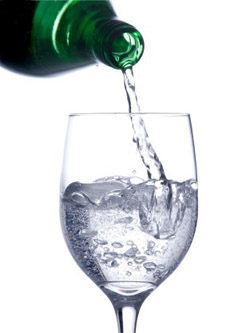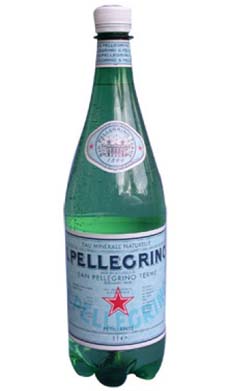
 From aquifers deep beneath the earth...to your glass. Photo by Grove B | IST
October 2005
Last Updated April 2013 |
 |
All Types Of Water
Water Terms & Definitions
Page 3: Letters N ~ P
A glossary of all types of water. On this page, you’ll find water terms such as Natural Water, Pure Water and Purified Water. If you enjoy this Water Glossary, we have a food glossary for almost every category of food.
Click a letter to go to the appropriate glossary section.
a b c d e f g h i j k l m n o p q r s t u v w x y z
This glossary is protected by copyright. It cannot be reproduced in whole or in part.
You are welcome to link to it.
|
NATURAL SPARKLING WATER
Water that is naturally effervescent and has been treated with carbon dioxide, but retains the same amount of carbon dioxide that it had when it emerged from the source.
NATURAL WATER or NATURALLY BOTTLED WATER
Water bottled exactly as it exists in its source, with no treatment or alteration. As distinguished from commodity products (distilled municipal waters like Aquafina, Dasani and others) these waters are very special and express their terroir. They are bottled at the source and treated as minimally as necessary. Some are naturally carbonated. All have a unique composition of minerals, based on their journey through the earth, that dictates their flavor: some are flavorless and some taste of heavy concentrations of mineral salts. Some waters are as young as 30 days old and some more than 20,000 years. Many have long been associated with curative powers due to their unique composition of minerals and trace elements. The emphasis is on the specialness of water and its source: to call it “bottled,” the bottle is just the means of getting it to you.
NITRATE
Nitrate is an inorganic compound; its chemical symbol is NO3. High levels ingested are potentially dangerous. Common sources of nitrate contamination into the water supply include fertilizers, animal wastes, septic tanks, municipal sewage treatment systems and decaying plant debris. It is highly leachable and readily moves with water through the soil; with excessive rainfall or over-irrigation, nitrate may eventually reach groundwater. Nitrate in water is colorless, odorless, and tasteless and is undetectable without testing. Water naturally contains less than 1 milligram of nitrate per liter (1 mg/l): The nitrate level on a bottled water label is a good indication of the purity of the water: higher levels of nitrate indicate that the water has been contaminated in some way. The U.S. federal drinking water standards for nitrates is set at 10 milligrams per liter (this standard has been criticized because it provides no margin of safety, ignores potentially sensitive populations and ignores other potential health affects of nitrates). Nitrate can be removed from drinking water by distillation, reverse osmosis and ion exchange. Home treatment equipment using these processes is available; however, carbon adsorption filters, mechanical filters and standard water softeners do not remove nitrate or nitrogen, and boiling water will increase rather than decrease the nitrate concentration. According to the World Health Organization, most adults ingest 20 to 70 milligrams of nitrate-nitrogen per day, mostly from foods like lettuce, celery, beets and spinach. Nitrate exposure from foods is not thought to be harmful.
PET
PET stands for polyethylene terephthalate, a plastic resin and a form of polyester. PET is the type of plastic labeled with the code “1” on or near the bottom of bottles and containers. It is commonly used to package soft drinks, water, juice, and other products. Manufacturers use PET instead of glass because of its strength, thermostability and transparency. Benefits to customers include lower expense, lightweight, resealable, and shatter-resistant and recyclable. The only concern with the reuse of PET bottles is that when used for refilling, bacteria can grow if bottles are not properly washed and dried.
pH
The pH value indicates the degree of alkalinity or acidity of the water. The pH scale ranges between 0 and 14. Water with a pH of 7 is neutral; a pH of less than 7 is acidic; a pH greater than 7 is alkaline. If the water has a pH of less than 4 the water may have a sour taste. Water with a pH greater than 8.5 has an unpleasant taste. |
|

San Pellegrino in a PET plastic bottle. Photo courtesy San Pellegrino. |
POLISHED
An industry term for mineral-enhanced water, i.e., any water whose chemistry is artificially altered for whatever reason. A polished water is a processed water.
POTABLE WATER
Any water consumable by humans; drinking water.
PROCESSED WATER
One that has been altered or treated, i.e., not a natural water.
PURE WATER
In a textbook definition, water in its “pure form” is odorless, tasteless, and nearly colorless (it has a slight hint of blue). However, fine mineral waters can have tastes and odors reflective of their acknowledged levels of total dissolved solids. While this does not make them technically “pure,” they can be in fact more beneficial and healthful than “pure” water; and in fact are preferred to “pure” water for these reasons.
PURIFIED WATER
Surface water or groundwater, generally municipal water, that has been treated for human consumption by distillation, deionization, reverse osmosis or other process. Mineral salts are added in the bottling process. It is not a natural product. Aquafina and Dasani are examples.
Go To Page 4: Water Terms Letter S ~ W
Return To The Article Index Above

|




 From aquifers deep beneath the earth...to your glass. Photo by Grove B | IST
From aquifers deep beneath the earth...to your glass. Photo by Grove B | IST 